 |






|
 |
 |
III. Digitalisation and Biotechnology:
Chances and Challenges for Future Societies
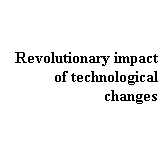 The
innovative power of digital networking and advances in biological science
are developing revolutionary impact. This will globally change present
forms of work, communication, entertainment, education, business, leisure
time, and health. Digitalisation and biotechnology will not only become
sources of new value creation, but will also aid in solving current ecological
and economic problems. Scenarios for development of both areas call for
social means of coming to terms with this upheaval. The
innovative power of digital networking and advances in biological science
are developing revolutionary impact. This will globally change present
forms of work, communication, entertainment, education, business, leisure
time, and health. Digitalisation and biotechnology will not only become
sources of new value creation, but will also aid in solving current ecological
and economic problems. Scenarios for development of both areas call for
social means of coming to terms with this upheaval.
Digitalisation
Digitalisation enables the optimising of various technological information
systems. It marks the connection of telecommunications with computer and
satellite technology, and with consumer electronics. In conjunction with
the construction of comprehensive data connections and the development
of new storage media, digitalisation enables communication to overcome
borders and span the entire world. According to some estimates, by the
year 2020 it will be possible for people in all corners of the earth to
attain all publicly accessible information and contact any other person,
if they so desire. As a result, a global market will arise, a virtual
continent so to speak, which will broaden the materialism of the real
world with a new dimension. In the next qualitative development phase,
quantum and DNA computers will overcome capacity and transmission deficiencies
in digital methods by combining molecular and optical technologies.
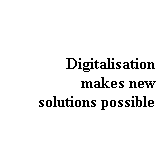 Digitalisation
opens up new concepts and solutions in all data-intense areas, i.e. employment,
education, and infrastructure. Thanks to digitalisation, homes will become
interactive systems capable of determining the residents' needs via sensors
and adapting accordingly. Automobiles, aeroplanes, and railways will become
increasingly more intelligent with digital control methods and will be
able to steer themselves over long distances via autopilot, seek out the
best routes, and offer their own communication possibilities. In medicine
'shrinking' technology will play an increasingly prominent role. Nanorobots
may be able to mill through plugged arteries, implanted biochips to monitor
oneís health, and minicomputers to partially replace lost senses in the
blind and deaf. Digitalisation
opens up new concepts and solutions in all data-intense areas, i.e. employment,
education, and infrastructure. Thanks to digitalisation, homes will become
interactive systems capable of determining the residents' needs via sensors
and adapting accordingly. Automobiles, aeroplanes, and railways will become
increasingly more intelligent with digital control methods and will be
able to steer themselves over long distances via autopilot, seek out the
best routes, and offer their own communication possibilities. In medicine
'shrinking' technology will play an increasingly prominent role. Nanorobots
may be able to mill through plugged arteries, implanted biochips to monitor
oneís health, and minicomputers to partially replace lost senses in the
blind and deaf.
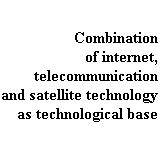 The
basic framework of a networked and digital world is the internet with
its commercial subsystems and the growing number of intranet set-ups in
firms and institutions. Furthermore, world-wide communication is developing
in leaps and bounds. Since 1959, 3000 communication satellites have been
put into orbit. With our multimedia world, the requirements for communication
capable of overcoming boundaries in time and space have fully developed.
In doing so, digitalisation has considerable impact on the production
of goods and services, understanding among people, execution of political
power, and lastly on essential organisational aspects of everyday life. The
basic framework of a networked and digital world is the internet with
its commercial subsystems and the growing number of intranet set-ups in
firms and institutions. Furthermore, world-wide communication is developing
in leaps and bounds. Since 1959, 3000 communication satellites have been
put into orbit. With our multimedia world, the requirements for communication
capable of overcoming boundaries in time and space have fully developed.
In doing so, digitalisation has considerable impact on the production
of goods and services, understanding among people, execution of political
power, and lastly on essential organisational aspects of everyday life.
In 1993, only ten million people were internet users. At present, the
number is doubling every 100 days. Estimates show that by the end of 2001
nearly 225 million people world wide will use the internet. If one projects
this development, then by the year 2010 three billion people will be using
the net. While the innovations of radio, telephone, and television required
decades to become integrated into society, the internet has asserted itself
in only a few years.
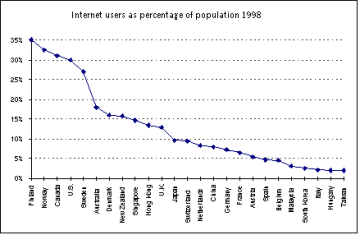
Source: Nua Ltd.
With its growing density, the internet is becoming a medium that requires
regulation and orientation. Data protection and the guarding of intellectual
property require effective international decisions regarding general legal
conditions. The distribution of child pornography or political extremist
content demonstrates that the freedom of the data network must be regulated
by a responsible society.
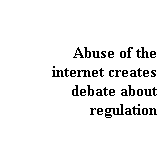 The
internet's freedom undercuts all possibilities for authoritarian political
systems to monitor economic, cultural, and political communication. Countries
like China or Singapore, where the government is seeking to control internet
usage, will test whether open communication promotes social stability
or political conflict. At present however, internet use is still quite
limited and is therefore less threatening for the authoritarian state.
Sooner or later the internet will undoubtedly become a powerful factor
that, along with economic modernisation, will influence Chinaís political
and social development. The
internet's freedom undercuts all possibilities for authoritarian political
systems to monitor economic, cultural, and political communication. Countries
like China or Singapore, where the government is seeking to control internet
usage, will test whether open communication promotes social stability
or political conflict. At present however, internet use is still quite
limited and is therefore less threatening for the authoritarian state.
Sooner or later the internet will undoubtedly become a powerful factor
that, along with economic modernisation, will influence Chinaís political
and social development.
The Development Differential of the Digital Revolution
The transition to a global communication society, the access to information
and knowledge will split the international community. There is a gap between
the highly developed information societies and the emerging markets on
one side, and developing nations on the other. If nothing changes, only
a fraction of humankind will profit from the opportunities communication
has to offer. To illustrate: there are just as many telephones in Tokyo
as in all of sub-Saharan Africa; world-wide, approximately four billion
people live more than two hours from the nearest telephone; a mere 0.1%
of Africans have internet hook-up; one could provide for an entire family
for one year in Bangladesh for the cost of internet access.
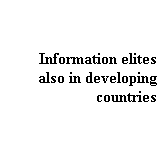 Emerging
markets like India, Malaysia, or South Korea are becoming high-tech islands,
offering competitive information and service products world-wide. The
Indian Silicon Valley, Bangalore, as well as the Korean high-tech centre
Anmyon, prove that the high-calibre education of many Asian natural and
engineering scientists is producing a new group of pioneers and top performers
familiar with modern high technology, and who are able to produce innovative
products and services. Global digitalisation allows emerging economies
to progress without having to pass through all the classical steps of
industrial and infrastructural development. With access to specialised
literature, media, television, and advanced communication, including world-spanning
networks, the ability to use global information, and the opportunities
provided by a comprehensive education consequently decide who wins and
who loses in the new economy. Emerging
markets like India, Malaysia, or South Korea are becoming high-tech islands,
offering competitive information and service products world-wide. The
Indian Silicon Valley, Bangalore, as well as the Korean high-tech centre
Anmyon, prove that the high-calibre education of many Asian natural and
engineering scientists is producing a new group of pioneers and top performers
familiar with modern high technology, and who are able to produce innovative
products and services. Global digitalisation allows emerging economies
to progress without having to pass through all the classical steps of
industrial and infrastructural development. With access to specialised
literature, media, television, and advanced communication, including world-spanning
networks, the ability to use global information, and the opportunities
provided by a comprehensive education consequently decide who wins and
who loses in the new economy.
Digital Employment and Society
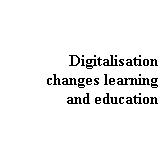 The
creation of virtual worlds revolutionises the education systems from elementary
school right up the universities. In the next century, humans will be
able to speak with computers; a telephone call with a foreigner will probably
no longer require an interpreter, thanks to connected artificial intelligence.
An interpreting telephone the size of a wristwatch will be able to perform
this service. The
creation of virtual worlds revolutionises the education systems from elementary
school right up the universities. In the next century, humans will be
able to speak with computers; a telephone call with a foreigner will probably
no longer require an interpreter, thanks to connected artificial intelligence.
An interpreting telephone the size of a wristwatch will be able to perform
this service.
Subject matters and research results can be communicated globally and
connectively without any great loss of time. Mutual adoption of best practices
will be made easier. By reducing costs and subsidising access, the disadvantaged
can be aided. For those with physically limited mobility, the interactive
elements of the internet open up easy access to the world.
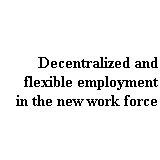 Volunteer employment is finding both offers and inquiries in the internet.
Civilian society is supported by physical as well as virtual neighbourhoods.
The necessary flexibility of the future working world can be enhanced
by internet utilisation. The economic, ecological, and social costs of
this mobility are sinking. Increases in knowledge and project work, whose
raw material is information, can be carried out via the decentralised
set-up of networked employment places. The digitalisation of work routines
will increase productivity by 20% and in doing so improve the competitiveness
of companies. As a result, digitalisation opens up organisation potential
corresponding to the needs of a flexible working world, but does not have
to stand in the way of individual desires of self-realisation.
Volunteer employment is finding both offers and inquiries in the internet.
Civilian society is supported by physical as well as virtual neighbourhoods.
The necessary flexibility of the future working world can be enhanced
by internet utilisation. The economic, ecological, and social costs of
this mobility are sinking. Increases in knowledge and project work, whose
raw material is information, can be carried out via the decentralised
set-up of networked employment places. The digitalisation of work routines
will increase productivity by 20% and in doing so improve the competitiveness
of companies. As a result, digitalisation opens up organisation potential
corresponding to the needs of a flexible working world, but does not have
to stand in the way of individual desires of self-realisation.
Digitalisation restructures future societies according to the intensity
of participation and the shaping role of social groups. On the other hand,
digitalisation can also contribute to moderating the division lines of
globalisation within society, i.e. sectors of society that presently hold
a small share in this process, and whose life and working world are particularly
regional and locally influenced, will be balanced against the transnational
acting elite in the economy, administration, and society. The experiences
of global interaction will only open up to this circle indirectly. Politically,
the dividing lines could lead to opposition between elitist and populist
representation of interests. The digitalisation of civil society and networking
over borders and experience scopes can fill at least a gap in experience
by opening to the wider world personal and professional circles that had
been limited to a local outlook. For example, a plumber whose market was
and is local may order spare parts from international suppliers over the
internet, or a member of a local citizens' initiative may exchange ideas
and experiences with other local activists in distant locations.
Motor of a New Economy
Together with the life sciences and other highly productive digital sectors,
the information business is laying the corner-stone of a new economy.
Information will take first place among the production factors of the
future economy. Concepts, content, and assessment services for the national
and international financial, goods, and service markets, as well as consulting
firms for companies, offers for continuing education, and the strengthening
of individual and social competence are all shifting to the center of
the new economy. The world of material goods exists beside that of digital
products.
 The
digitalisation of information urges the integration of once separate industrial
sectors. The value-creation chains of telecommunication, media and information
technology are growing together in complex relations. The borders between
media firms as information providers as well as telecommunication and
internet ventures as technical service providers are merging. Large telecommunication
or media groups have either founded or bought internet service provider
firms, or are in co-operation with online services, through which more
and more people enter the internet daily. Using digital technology, television
pictures, radio programmes, web pages, and telephone calls can be transmitted
within converged formats and be used interactively in increasing amounts. The
digitalisation of information urges the integration of once separate industrial
sectors. The value-creation chains of telecommunication, media and information
technology are growing together in complex relations. The borders between
media firms as information providers as well as telecommunication and
internet ventures as technical service providers are merging. Large telecommunication
or media groups have either founded or bought internet service provider
firms, or are in co-operation with online services, through which more
and more people enter the internet daily. Using digital technology, television
pictures, radio programmes, web pages, and telephone calls can be transmitted
within converged formats and be used interactively in increasing amounts.
Ecological Prospects
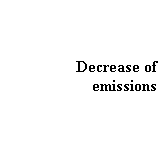 Digital
expansion in the economy is growth without limits. That is to say, without
the limits defined to date by energy and raw material consumption. Digitalisation
will re-shape economic growth to be more ecologically tolerable, i.e.
a decentralised internationally networked information society reduces
transport costs and traffic flow, and digital waste does not require disposal
sites. Optimising electronic control of production facilities will diminish
both the energy input and the pollutant output of industrial manufacturing.
In this way, digitalisation will become a pillar of ecological sustainability. Digital
expansion in the economy is growth without limits. That is to say, without
the limits defined to date by energy and raw material consumption. Digitalisation
will re-shape economic growth to be more ecologically tolerable, i.e.
a decentralised internationally networked information society reduces
transport costs and traffic flow, and digital waste does not require disposal
sites. Optimising electronic control of production facilities will diminish
both the energy input and the pollutant output of industrial manufacturing.
In this way, digitalisation will become a pillar of ecological sustainability.
Technological solutions alone, however, are not sufficient guarantees
of sustainability. Savings on resource consumption are offset by feedback
effects. An increase in resource productivity can create new needs and
trigger greater consumption by sinking prices, raising product quality,
or creating follow-up products. The original limited use of natural resources
is thereby surpassed.
Potential in Biotechnology and Genetic Engineering
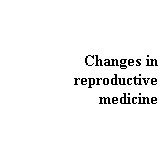 Biotechnology
and genetic engineering make it possible not only to heal disease, but
also to act preventively before an outbreak occurs with an early diagnosis,
thus possibly enabling many risks to be eliminated. In fifty years, it
will be possible to identify and delay physical wear and tear and life
expectancy will rise to over 90 years of age. By the year 2005, the three
billion genetic material components will be deciphered, and in 25 years
it will be possible to specifically correct the genotype. By the year
2010, cell and tissue cultures are to be used in the production of transplant
organs. Donor and receiver can be one and the same, so as to bypass rejection
reactions and the moral problems of organ donations. Already at present
a specific cloning of animals is emerging, enabling the production of
valuable performance animals that could be used to produce vaccines, to
name but one example. Biotechnology
and genetic engineering make it possible not only to heal disease, but
also to act preventively before an outbreak occurs with an early diagnosis,
thus possibly enabling many risks to be eliminated. In fifty years, it
will be possible to identify and delay physical wear and tear and life
expectancy will rise to over 90 years of age. By the year 2005, the three
billion genetic material components will be deciphered, and in 25 years
it will be possible to specifically correct the genotype. By the year
2010, cell and tissue cultures are to be used in the production of transplant
organs. Donor and receiver can be one and the same, so as to bypass rejection
reactions and the moral problems of organ donations. Already at present
a specific cloning of animals is emerging, enabling the production of
valuable performance animals that could be used to produce vaccines, to
name but one example.
Reproduction in this scenario is not a foregone conclusion, and certainly
no accident. Over 3,000 test-tube babies are born world-wide each year
and their numbers are increasing steadily as a result of ever-increasing
parental age. The possibility of genetic engineering via artificial insemination
will further change attitudes towards reproduction. This will have distinct
consequences:
- The generational change will be delayed even further.
- Gene analysis and reproductive medicine methods will allow for correction
of genetic make-up and force us to redefine the ethical foundations
of our future societies.
- Families will find new forms if people enter relationships for a limited
time but have children for the long run.
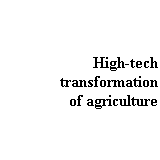 Biotechnology
also opens up possibilities for feeding a growing world population. A
large part of agriculture is changing over to a capital intensive and
research-oriented high-tech sector, as well as an industry in which DNA
can be described, patented, and possessed. In 2025, more than 85% of humankind
will live in developing nations and in order to guarantee adequate nutrition
for all, agricultural production must increase by 75%. Biotechnology
also opens up possibilities for feeding a growing world population. A
large part of agriculture is changing over to a capital intensive and
research-oriented high-tech sector, as well as an industry in which DNA
can be described, patented, and possessed. In 2025, more than 85% of humankind
will live in developing nations and in order to guarantee adequate nutrition
for all, agricultural production must increase by 75%.
Biotechnology presents itself as a basis for environmentally friendly
foodstuff cultivation. The world-wide available space for agriculture
is not decisively extendable and the present forms of intense cultivation
are, to a great extent, exhausted. On this basis, biotechnology will become
the key factor in foodstuff production for a world of 8 billion inhabitants.
However, it will only be able to eliminate world hunger in connection
with a more effective distribution system.
Socio-political and Medical Justice
Better nutrition, improved medical care, and the prospects of biotechnology
and genetic engineering create new general conditions of social policy.
Japan, Germany, and Sweden belong to the oldest countries, i.e. the percentage
of those older than 60 years of age is over 20%. In China, this group
is growing seven times faster than the entire population.
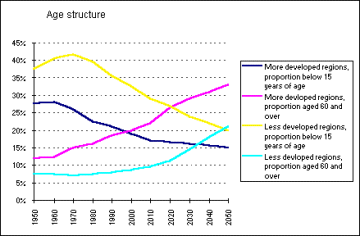
Source: United Nations
The number of elderly compared to young will sharply increase. This shift
is caused by sinking birth rates, creating a decreasing number of potential
contributors to national welfare systems. Rising life expectancy leads
to higher service claims. The average length of time on pension will rise.
Pressure to adapt is especially great in countries like Germany and Italy,
whose old-age pension systems are financed by current budgets and not
capital. If the percentage of elderly is still increasing at current rates
in 2025, the old-age pension percentage share of the gross national product
will increase and the additional burden will have to be carried by the
employed generation in the form of higher contributions or taxes.
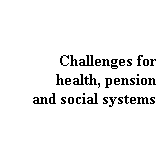 An
additional problem is access to expensive medical treatment. The development
of gene therapeutic procedures and medications results in costs. Although
treatment costs can be reduced by using genetic engineering prevention,
in the end the advances in technological medicine may consequently cause
greater financial strain. This is relevant when considering the concept
and type of medical and old-age security systems. Such systems must establish
fairness concerning universal distribution and care protection. In addition,
a growing senior population causes total social expenditures to rise for
treatment of disease and other health care. Unless, of course, one wants
to accept restrictions on health welfare for seniors. An
additional problem is access to expensive medical treatment. The development
of gene therapeutic procedures and medications results in costs. Although
treatment costs can be reduced by using genetic engineering prevention,
in the end the advances in technological medicine may consequently cause
greater financial strain. This is relevant when considering the concept
and type of medical and old-age security systems. Such systems must establish
fairness concerning universal distribution and care protection. In addition,
a growing senior population causes total social expenditures to rise for
treatment of disease and other health care. Unless, of course, one wants
to accept restrictions on health welfare for seniors.
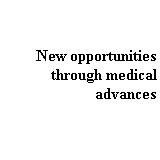 New
opportunities oppose these possible burdens; life expectancy, health situation,
and the upheavals in the work world point towards a longer working life
instead of a shorter one. The performance limits that are still predominantly
physically defined are being measured anew. The active life span is extending.
New medical procedures could prevent long-term disease, heal addictions,
and drastically reduce care costs. In total, some costs will rise, but
realisable savings have the potential to balance out the increase. New
opportunities oppose these possible burdens; life expectancy, health situation,
and the upheavals in the work world point towards a longer working life
instead of a shorter one. The performance limits that are still predominantly
physically defined are being measured anew. The active life span is extending.
New medical procedures could prevent long-term disease, heal addictions,
and drastically reduce care costs. In total, some costs will rise, but
realisable savings have the potential to balance out the increase.
Ethics of Biotechnology and Genetic Engineering
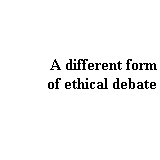 The
possibilities of reproductive medicine ask anew the question of the ethics
of progress. The key task is to supplement medical or economic decisions
to use genetically engineered intervention with ethical criteria. One
can not sweepingly condemn all forms of genetic engineering on an ethical
basis if they promise to conquer genetic defects endangering human life.
The production of insulin with genetic engineering does not create an
ethical problem. Furthermore, the use of genetic engineering, similar
to digitalisation, allows for more consistent, and with that more sustainable,
procedures. For example, by cultivating genetically altered plants the
US has already saved using thousands of tonnes of pesticides. The
possibilities of reproductive medicine ask anew the question of the ethics
of progress. The key task is to supplement medical or economic decisions
to use genetically engineered intervention with ethical criteria. One
can not sweepingly condemn all forms of genetic engineering on an ethical
basis if they promise to conquer genetic defects endangering human life.
The production of insulin with genetic engineering does not create an
ethical problem. Furthermore, the use of genetic engineering, similar
to digitalisation, allows for more consistent, and with that more sustainable,
procedures. For example, by cultivating genetically altered plants the
US has already saved using thousands of tonnes of pesticides.
At present, however, we are one not nearly in the position to ignore all
the implications of genetic engineering - a control problem in view of
the speed of developments in genetic research. The combination of reproductive
medicine and human germline engineering seems to be especially problematic
for society and is discussed with much controversy. American scientists
have already successfully developed a procedure of allowing parents to
choose the sex of their child. Children could be made better or fitter
than the average. 'People made-to-measure' are a part of a scenario of
possibilities which could sharpen future society's conflict potential.
Contents
Chapter 1
Chapter 2
Chapter 3
Chapter 4
TOP
|
 |